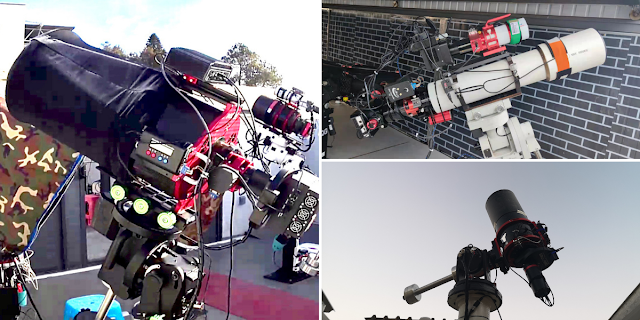We are excited to introduce three affiliate remote telescopes added to Insight Observatory's image set repository, Starbase.
The first two are an AG Optical 10" truss iDK (AFIL-1) located at Gemini Observatory and a Skyrover 130 APO Pro (AFIL-2) located at Yunling Observatory, China. These two imaging systems are owned and operated by Alpha Zhang.
The Heart of the Rosette Nebula (also known as Caldwell 49) is an H II region located near one end of a giant molecular cloud in the Monoceros region of the Milky Way Galaxy. The open cluster NGC 2244 (Caldwell 50) is closely associated with nebulosity, the stars of the cluster having been formed from the nebula's matter.
The third telescope is a Veloce 200 RH f/3 in Hakos, Namibia (AFIL-5). This remote imaging system has been on our remote telescope network for over a year now offering services on our Personal Image Request (PIR), Basic Image Request (BIR), and Advanced Imaging Request (AIR) online applications. The BIR and AIR are available via the ATEO Portal. AFIL-5 is owned and operated by Lukas Demetz from SkyGems Observatories.
C/2021 A1 (Leonard) is an inbound long-period comet discovered by G. J. Leonard at the Mount Lemmon Observatory on 3 January 2021 when the comet was 5 astronomical units (AU) from the Sun. This was the first comet discovered in 2021 and it has a retrograde orbit.
Starbase is a repository of image data captured by the Astronomical Telescopes for Educational Outreach (ATEO) and our affiliate remote telescopes (AFIL), organized by the image target into image “sets”. These image sets can be purchased (referred to as “subscribing” to the image set) and downloaded. All proceeds from Starbase subscriptions go towards funding our educational outreach programs.
Read More
The first two are an AG Optical 10" truss iDK (AFIL-1) located at Gemini Observatory and a Skyrover 130 APO Pro (AFIL-2) located at Yunling Observatory, China. These two imaging systems are owned and operated by Alpha Zhang.
The Heart of the Rosette Nebula (also known as Caldwell 49) is an H II region located near one end of a giant molecular cloud in the Monoceros region of the Milky Way Galaxy. The open cluster NGC 2244 (Caldwell 50) is closely associated with nebulosity, the stars of the cluster having been formed from the nebula's matter.
The third telescope is a Veloce 200 RH f/3 in Hakos, Namibia (AFIL-5). This remote imaging system has been on our remote telescope network for over a year now offering services on our Personal Image Request (PIR), Basic Image Request (BIR), and Advanced Imaging Request (AIR) online applications. The BIR and AIR are available via the ATEO Portal. AFIL-5 is owned and operated by Lukas Demetz from SkyGems Observatories.
C/2021 A1 (Leonard) is an inbound long-period comet discovered by G. J. Leonard at the Mount Lemmon Observatory on 3 January 2021 when the comet was 5 astronomical units (AU) from the Sun. This was the first comet discovered in 2021 and it has a retrograde orbit.
 |
| AFIL-1: AG10 CDK f/6.7 f=1665mm (left), AFIL-2: SkyRover 130 APO Pro f/7 f=910mm (upper right), and AFIL-5: Officina Stellare Veloce 200mm f/3 Astrograph (lower left). |
Starbase is a repository of image data captured by the Astronomical Telescopes for Educational Outreach (ATEO) and our affiliate remote telescopes (AFIL), organized by the image target into image “sets”. These image sets can be purchased (referred to as “subscribing” to the image set) and downloaded. All proceeds from Starbase subscriptions go towards funding our educational outreach programs.





